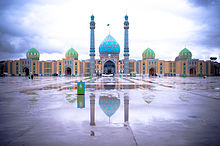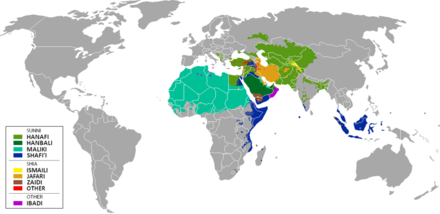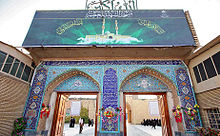Twelver
The Twelver Shia (Arabic الشيعة الإثنا عشرية asch-Shīʿa al-Ithnā ʿAscharīya, DMG aš-Šīʿa al-Iṯnā ʿAšarīya) is that branch within the Shia according to whose teachings there are a total of twelve Imams. The first of these is ʿAlī ibn Abī Tālib, the last Muhammad al-Mahdī, who is said to live in obscurity and return only at the end of time. The Twelver Shiites form the overwhelming majority of Shiites, accounting for 80% of the total, which is why they are often referred to only generally as the Shiites. Their total number is estimated at 175 million and their share of the Muslim population worldwide at 11 percent. In the countries of Iran, Azerbaijan, Iraq and Bahrain, the Twelver Shiites constitute the majority of the population. In addition, significant Twelver Shia minorities live in Pakistan, India, Afghanistan, Lebanon, Nigeria, Indonesia, Tanzania, and Turkey. Smaller minorities exist in other countries in Africa, Europe, America and Asia.
The Twelver Shiʿa has its own school of law, which is called Jafarite after the sixth Imam Jafar as-Sādiq. In the constitution of the Islamic Republic of Iran (Article 12), Islam of the Twelver Shiite, Jafarite school is enshrined as the never-changing religion of the state.
The term "Twelver" (Iṯnā ʿAšarīya) for those Shiites who believe in the rapture and return of the twelfth Imam did not become widespread until the end of the 10th century. The Twelver Shi'a are also referred to as Imamites, though the two terms do not coincide completely in meaning, for in the Middle Ages there were various other Imamite groupings besides the Twelver Shi'a that did not limit the number of Imams to twelve. Authors of Sunni and Zaidite orientation also referred to this direction of the Shia as Qatʿīya until the early 13th century. The name is explained by the fact that the Twelver Shiites, unlike other Shiites, assumed with certainty (qaṭʿan) that the seventh Imam Mūsā al-Kāzim had died and designated his son ʿAlī ar-Ridā as his successor. Another polemical term used for the Twelver Shiites is Rāfida.

The Jamkarān Mosque near Ghom, one of the holy sites of the Twelver Shia. The twelfth Imam is said to have appeared here in the 10th century.
Distribution and number of followers
The following table, based on 2014 estimates by Moojan Momen, provides an overview of the total number and proportion of Twelver Shiites in the population of various countries, as well as their main settlement areas. Only countries with more than 500,000 followers are taken into account.
| Country | Total numberin million | Share in percent | Most important settlement areas |
| Iran | 69 | 90 | |
| Pakistan | 28 | 15 | Karachi, Lahore, Gilgit-Baltistan |
| India | 25 | 2 | Uttar Pradesh, Bihar, West Bengal, Andhra Pradesh, Kashmir |
| Iraq | 21 | 63 | Rural regions of the southern provinces of Karbala, Hilla, Diwaniyya, Wasit, Maisan as well as Sadr City |
| Azerbaijan | 7,5 | 80 | |
| Afghanistan | 4 | 12 | Settlement areas of the Hazara |
| Turkey | 3 | 4 | Provinces of Kars, Iğdır |
| Saudi Arabia | 2 | 7 | Province of ash-Sharqiyya, in particular al-Qatīf. |
| Lebanon | 2 | 40 | Jabal Amil, Northern Bekaa Plain |
| Nigeria | 2 | 1 | |
| Indonesia | 2 | < 1 | |
| Tanzania | 1 | 2 | Arusha, Dar-es-Salam, Zanzibar, Bukoba, Lindi |
| Egypt | 0,8 | 1 | |
| United Arab Emirates | 0,6 | 7 | |
| Bahrain | 0,6 | 45 | |
| Kuwait | 0,5 | 30 | Failaka |

Overview of the geographical distribution of the different Islamic directions. The Twelver Shiite areas are tinted in orange ("JAFARI").
Doctrine of the Faith
The Twelve Imams and the Fourteen Infallibles
| The twelve Imams of the Twelver Shia | |
| 1. | ʿAlī ibn Abī Tālib (d. 661) |
| 2. | al-Hasan ibn ʿAlī (d. 670) |
| 3. | al-Husain ibn ʿAlī (d. 680) |
| 4. | ʿAlī ibn Husain Zain al-ʿĀbidīn (d. 713) |
| 5. | Muhammad al-Bāqir (d. 732 or 736) |
| 6. | Jafar as-Sadiq (d. 765) |
| 7. | Mūsā al-Kāzim (d. 799) |
| 8. | ʿAlī ar-Ridā (d. 818) |
| 9. | Muhammad al-Jawad (d. 835) |
| 10. | ʿAlī al-Hādī (d. 868) |
| 11. | Hasan al-ʿAskarī (d. 874) |
| 12. | Muhammad al-Mahdī (Raptured). |
The core idea of the Twelver Shiite doctrine is the belief in the twelve imams: they are considered infallible and are said to have been established by designation (naṣṣ) of their predecessor. The first Imam ʿAlī ibn Abī Tālib was, according to Twelver Shi'ite belief, appointed directly by Muhammad, in the spring of 632 after returning from the farewell pilgrimage at Ghadīr Chumm. Twelver Shi'is commemorate this event with the Ghadīr festival on the 18th of Dhū l-Hiddshah. According to Twelver Shi'ite doctrine, ʿAlī's imamate did not begin in 656, when he was elevated to caliph, but immediately following Muhammad's death, without interruption (bilā fāṣila). The commitment to this doctrine is considered a religious duty (farḍ min ad-dīn).
The Shiite believer has a duty to the imams to practice Walāya and Barā'a, i.e. he should support the imams and all those who are loyal to them and, conversely, renounce those who hate them. As a community that is loyal to its Imams, the Twelver Shi'is see themselves as following in the footsteps of the Chosen People of the Israelites, who also practiced Walāya towards their prophets. According to classical Twelver Shi'a doctrine, if the manifestation of one's faith poses a danger to the believer, he is empowered to conceal it in the form of Taqīya. The Twelver Shi'a has inherited numerous traditions on the Taqīya from the earlier Imamite tradition. Today's Twelver Shi'ites, however, for the most part no longer attach particular importance to this principle.
Like the prophets, the imams are supposed to be able to intercede (šafāʿa) for the Shiite believers on the Last Day so that they will be spared from punishment in the hereafter. According to Twelver Shiite doctrine, the imams are also considered Muhaddathūn, i.e., people who are "addressed" by angels who impart divine knowledge to them through inspiration. Conversely, to this day, some Twelver Shi'i scholars present themselves as interlocutors of the Imams who have transmitted charisma to them through dreams and visions. Visions and dreams of the Imams play an important role in Twelver Shiite mysticism to this day.
According to Twelver Shi'ite doctrine, the number of the twelve Imams had been determined long before the Rapture of the twelfth Imam. This is justified, among other things, by the fact that they are already mentioned in the Kitāb Sulaim ibn Qais, which ʿAlī's follower Sulaim is said to have compiled. Together with Muhammad and his daughter Fatima, the Twelve Imams form the Fourteen Infallibles, who are depicted in many traditions as pure and sinless figures of light. The Twelver Shiites refer to Sura 33:33: "Indeed, God desires to take away the impurity from you, you 'People of the House' (ahl al-bait), and to purify you completely". The special status of the Fourteen Infallibles is also justified by the event of the Mubāhala, in which Muhammad took his daughter Fātima, her husband ʿAlī ibn Abī Tālib, and their two sons Hasan and Husain under his mantle. These five people are also called the Ahl al-kisā' ("People of the Mantle") in the Shia.
The twelfth Imam: small and great concealment
A central belief of the Twelver Shia is the doctrine of the Ghaiba, i.e. the hiddenness of the twelfth Imam. According to the Twelver Shiites, he did not die, but was raptured by God as a child and has lived in seclusion ever since. The Twelver Shiites believe that the twelfth Imam will one day return as Mahdi to complete the Prophet's mission and establish a kingdom of justice on earth. Hence his name Muhammad al-Mahdī. The disappearance of the Mahdi and his concealment are depicted in Shi'i traditions as a severe trial (imtiḥān) for the Shi'i believers.
According to Twelver Shi'i doctrine, concealment is divided into two periods: the first period of minor concealment (al-ġaiba al-ṣuġra), during which the twelfth Imam maintained contact with his followers through four messengers (sufarāʾ), and the second period of major concealment (al-ġaiba al-kubrā), which continues to this day and of which only God knows when it will end. The four messengers through whom the twelfth Imam was in contact with his followers during the minor concealment were:
- Abū ʿAmr ʿUthmān ibn Saʿīd al-ʿAmrī (d. before 880).
- Abū Jafar Muhammad ibn ʿUthmān al-ʿAmrī (d. 916 or 917)
- Abū l-Qāsim al-Husain ibn Rauh an-Naubachtī (d. June 938).
- Abū l-Hasan ʿAlī ibn Muhammad as-Simmarī (d. May 941).
These four ambassadors are said to have transmitted questions to the twelfth Imam and secretly delivered his answers. Shortly before his death in 329 of the Hijra (= 940/41 A.D.), the fourth messenger is said to have received a last letter signed by the hidden Imam, in which he declared that from now on and "until the end of time" no one could see him or be his representative, and whoever claimed otherwise was an impostor. Thus, according to the official Twelver Shi'ite doctrine, the period of great concealment begins. It is essentially this doctrine of the minor and major ghaiba that distinguishes the Twelver Shia from other Imamite groups. Twelver Shia theologians justify the doctrine of the two Ghaibas not only with Shia traditions, but also with precedents from Islamic salvation history: Thus Abraham and Mohammed are also said to have entered twice into concealment.
The twelfth Imam has a large number of epithets among the Twelver Shi'ites, including al-Qā'im ("the Rising One"), Sāhib az-zamān ("Commander of Time"), and al-Mahdī ("the Rightly Guided One"). When he is mentioned, it is customary to utter the formula ʿAǧǧala Llāhu faraǧahū ("May God speedily bring about his emergence"). The twelfth imam is also the only legitimate head of Muslims in the Twelver Shi'a faith. In the constitution of the Islamic Republic of Iran, he is therefore also the theoretical head of state. The Shiite jurist, who as Rahbar takes over the administration and leadership of the community, rules only by proxy of the twelfth Imam until his return from obscurity.
There are different traditions in the Twelver Shi'a concerning the place where the Imam-Mahdī is supposed to appear. One tradition states that the sixth Imam Jafar as-Sādiq foresaw that the descent of "the Rising One" (al-Qā'im), together with his followers and family members, would take place in the Sahla Mosque in Kufa and that he would continue to stay there. According to another tradition, on the other hand, transmitted by ash-Shaykh al-Mufīd, the Mahdi will descend at the Kaaba in Mecca and only then, accompanied by angels, move to Kufa. According to various Twelver Shi'ite traditions that originated in the milieu of the Ghulāt, the eschatological reappearance of the Mahdi is followed by the return (raǧʿa) of the Prophet Muhammad, the other eleven imams, and an unnamed number of Shi'ite believers, who take revenge on their former opponents on this occasion.
Special features in theology
The Twelver Shi'ite doctrine has some distinctive features, such as the concept of the Badā' and the rejection of the "vision of God" (ruʾyat Allāh). The concept of the Badā', which comes from the Imamite tradition, concerns the issue of predestination. Unlike the Sunnis and most other Shi'ites, the Imamites assume that God can change His decisions according to circumstances. 'Badā' is primarily an instrument of dealing with the past. Whenever things turned out differently than predicted, this can be explained by the fact that it seemed so good to God (badā la-hū). To justify the Badā'-doctrine, the Imamites invoke Sura 13:39: "God erases what He wills or makes it stand. With Him is the original scripture." The eighth Imam ʿAlī ar-Ridā is quoted as saying, "God never sent a prophet without the commission to forbid wine and to teach the Badā' of God."
The "vision of God" (ruʾyat Allāh) is about the question of whether or not people can see God with their eyes in this world and in the hereafter. While the Sunni theologians have answered this question in the affirmative, the Twelver Shi'ite theologians, adopting the muʿtazilite position, have taught the impossibility of the "vision of God".
Basic religious texts
As with the Sunnis, the Twelver Shi'a consider the Koran and the Hadith to be the most important basic religious texts. Since its beginnings, the Twelver Shia has been confronted with the accusation that it considers the Qur'anic text incomplete. In fact, there are Shi'a hadiths that report that the Qur'anic text has been falsified in individual places by the opponents of the Shi'a. For example, in Sura 3:33: "God chose Adam and Noah and the clan of Abraham and the clan of ʿImrāns before the people of all the earth," the phrase "and the clan of Muhammad" is said to have originally followed "the clan of ʿImrāns." A small minority of Twelver Shi'ites have even attempted to show that entire suras were deleted from the Qur'an. The majority of Twelver Shi'ites, however, assume that the text of the Qur'an is correct and also complete. Among the best-known Twelver Shi'i commentaries on the Qur'an are the Tafsīr of ʿAlī ibn Ibrāhīm al-Qummī (d. 919), at-Tibyān fī tafsīr al-Qurʾān of Abū Jafar at-Tūsī (d. 1067), Maǧmaʿ al-bayān by at-Tabrisī (d. 1154), and the two modern works al-Mīzān by the Iranian Allameh Tabatabai (d. 1981) and Min waḥy al-Qurʾān by the Lebanese Muhammad Husain Fadlallāh (d. 2010).
Since the Imams are considered infallible according to Twelver Shi'ite doctrine, news (aḫbār) about sayings and actions of them have the same status as hadiths. Reports about the Prophet Muhammad are usually accepted as authentic only if they have been transmitted by one of the Imams. Most of the other companions of the Prophet, on the other hand, are considered unreliable because they supported the caliphate of Abū Bakr, ʿUmar ibn al-Chattāb, and ʿUthmān ibn ʿAffān.
In all, there are four books that have canonical status among the Twelver Shi'ites. They have been compiled by three authors who are called the "three Muhammads":
- al-Kāfī fī ʿilm ad-dīn ("The Sufficient in Religious Studies") by Muhammad al-Kulainī (d. 940), a collection of 16,200 Imamite traditions arranged systematically by topic,
- Man lā yaḥḍuruhu al-faqīh ("He who has no jurist near him," i.e., he can get instruction from the book) by Muhammad ibn Bābawaih (918-991),
- Tahḏīb al-aḥkām ("Refinement of Judgments") by Muhammad at-Tūsī (995-1067),
- al-Istibṣār fī-mā uḫtulifa min al-aḫbār ("Consideration on the Deviations in the News") by the same author.
While the first book is purely a collection of traditions, the influence of fiqh is evident in the three later works: some of them contain detailed normative discussions. The fourth book deals specifically with the question of how to proceed with questions of norms on which there are traditions that seem to contradict each other.
In addition to the four books, there are several other works that are held in very high esteem by the Twelver Shi'a, such as the 110-volume monumental work Bihār al-Anwār by Muhammad Bāqir al-Madschlisī, which claims to contain all Shi'a traditions, and the Kitāb Sulaim ibn Qais, which is considered the oldest work of the Shi'a in general. It must be noted here that the Twelver Shi'a tradition collections contain a large number of traditions, opinions, and conceptions of other Shi'a sects, most of which no longer exist at all. The most important collections with Duʿā'-prayers among the Twelver Shiites are the Ṣaḥīfa-yi Saǧǧādīya and the Mafātīḥ al-ǧinān.

The Sahla Mosque in Kufa, one of the places where the descent of the twelfth Imam is expected.
Search within the encyclopedia